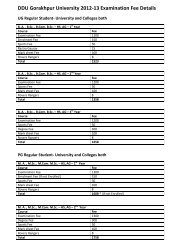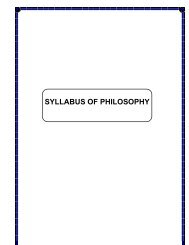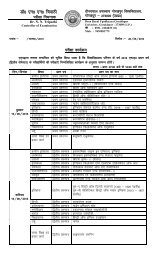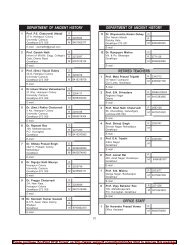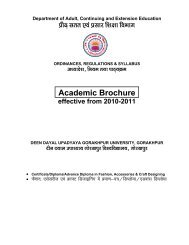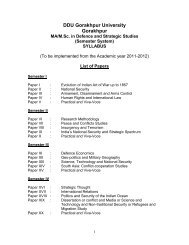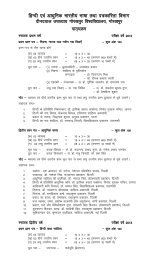B.Sc. I
B.Sc. I
B.Sc. I
You also want an ePaper? Increase the reach of your titles
YUMPU automatically turns print PDFs into web optimized ePapers that Google loves.
B.<strong>Sc</strong>. MICROBIOLOGY SYLLABUS<br />
DDU GORAKHPUR UNIVERSITY, GORAKHPUR<br />
B.<strong>Sc</strong>. I<br />
B.<strong>Sc</strong>. I: Three papers and a practical examination as follows:<br />
Paper I: Fundamental of Industrial Microbiology<br />
Papers II: Biostatistics Tools and Technology<br />
Papers III: Microbial Genetics and Molecular Biology<br />
Practical: Including Job Training<br />
45 Marks<br />
45 Marks<br />
45 Marks<br />
65 Marks<br />
Total: 200 Marks<br />
PAPER I<br />
FUNDAMENTAL OF INDUSTRIAL MICROBIOLOGY<br />
1. General Introduction, History and Development of Microbiology<br />
• <strong>Sc</strong>ope of Industrial Microbiology<br />
• Introduction<br />
• Discovery of Microbial world<br />
• The experiments of Pasteur, The discovery of the anaerobic life<br />
• The era of the discovery of antibiotics<br />
• The physiological significance of fermentation<br />
2. Classification, Isolation, characterization and ultra structure of microbes<br />
• Viruses<br />
• Bacteria: Cynobacteria, Eubacteria, Myxobacteria, Rickettsias, Spirochaites,<br />
Micoplasmas, Actinomycetes, Archaebacteria<br />
• Algae<br />
• Protozon<br />
• Fungi<br />
• Criteria of identification of microorganisms<br />
• Methods of staining of different microbes
B.<strong>Sc</strong>. MICROBIOLOGY SYLLABUS<br />
DDU GORAKHPUR UNIVERSITY, GORAKHPUR<br />
3. Biological and Biochemical fundamentals<br />
• Introduction<br />
• The microorganisms and biotechnology<br />
• Sterilization<br />
• Preparation of media<br />
• Isolation methods and Staining<br />
• Preservation of Microbes<br />
• Serial subculture, preservation with mineral oil<br />
• Lyophilisation<br />
• Principles of storage of microbes at very low temperature or in liquid nitrogen<br />
• Other methods for storage of fungi<br />
• Over production of microbial metabolites<br />
• Preparation of inoculation<br />
4. Fundamental of genetics<br />
• Introduction<br />
• Method for the selection of mutants, direct selection methods for resistant mutants,<br />
Penicillin selection technique, replica plating technique, other technique mutant selection,<br />
conditional lethality and its use in mutant selection.<br />
• General account about the transfer of genetic information in prokaryotes<br />
• <strong>Sc</strong>ope of genetic Engineering<br />
PRACTICAL ON PAPER I<br />
• Preparation of media, Autoclaving and sterilization of glassware, Maintenance of culture<br />
room.<br />
• Isolation and maintenance of microbes of different groups;<br />
a. Bacteria<br />
b. Algae<br />
c. Bacteriophage<br />
d. Fungi<br />
• Single spore culture of Fusarium<br />
• Camera Lucida drawing<br />
• Haemocytometer<br />
• Isolation of phytopathogens
B.<strong>Sc</strong>. MICROBIOLOGY SYLLABUS<br />
DDU GORAKHPUR UNIVERSITY, GORAKHPUR<br />
PAPER II<br />
BIOSTATISTICS TOOLS AND TECHNIQUES<br />
1. Biostatistics: Basic idea of probability, distribution patterns, normal, binomial and poison<br />
distribution, sampling methods mean, mode and media, chi-square statistics analysis of variance<br />
transformation, exponential, logarithmic functions.<br />
2. Microscopy: Light microscopy, phase contrast microscopy, florescence and electron<br />
microscopy.<br />
3. Chromatographic and Electrophoretic techniques: Basic idea of chromatography,<br />
electrophoresis, immune-electrophoresis and iso-elctrofocussing<br />
4. Instruments, basic principles and uses: pH meter, densietometry, fluorimetry, calorimetry,<br />
spectrophotometry, manometry, centrifugation.<br />
5. Principal types of fermentations: Fermenter design, differences between biochemical and<br />
chemical process, Classification of biochemical reaction rate process, Operational consideration,<br />
local condition within a fermenter, fermenter confugaration, the Bach fermenter, continuous<br />
stirred rank fermenter, the tubular fermenter, the condensed bed fermenter, solid state fermenter,<br />
Computer control fermentation process. Computer hardware and software, Hardware graphics,<br />
Lotus and das, Computer application in fermentation technology. Justification and Planning<br />
PRACTICAL ON PAPER-II<br />
1. Biostatistics: Problems on chi-square test, Problems on mean, mode and median<br />
2. Protein estimation by colorimeter with folin ciocoltura reagent<br />
3. Estimation of reducing sugars by colorimeter<br />
4. Paper chromatographic separation of amino acid and pigments by one way descending<br />
5. Paper chromatographic separation of sugars<br />
6. Paper chromatographic separation of organic acids<br />
7. Measurement of pH of fruits juice by pH meter<br />
8. Demonstration of electrophoretic separation of proteins
1. Nucleic acid:<br />
B.<strong>Sc</strong>. MICROBIOLOGY SYLLABUS<br />
DDU GORAKHPUR UNIVERSITY, GORAKHPUR<br />
PAPER III<br />
MICROBIAL GENETICS AND MOLECULAR BIOLOGY<br />
DNA as a genetic material, structure of DNA, RNA, DNA replication (conservative and<br />
semi-conservative replication, conformational flexibility of DNA), Replication of<br />
Eukaryotes. The Genetic codes, central dogma, reverse transcriptase, gene transcription<br />
polymerases, transcription product of DNA, t-RNA, mRNA. Synthesis of RNA in<br />
eukaryotes and prokaryotes, Catabolite effect, Operators and repressors, post<br />
transcriptional processing of RNA.<br />
2. Protein Synthesis:<br />
Translation and protein synthesis in eukaryotes and prokaryotes, t-RNA synthetase,<br />
activation of amino acid, inhibitors of protein synthesis. Gene expression catabolite<br />
repression, regulation of gene expression, Operon concept C AMP, catabolite activator<br />
protein (CAP), positive and negative control and gene expression in prokaryotes, Lac<br />
operon, Britten-Davidson model of gene regulation in eukaryotes.<br />
3. Mutagenesis and Gene Mutations:<br />
Induced mutation, molecular mechanism of mutation, forward and reverse mutation,<br />
transition-transverson, Mutation frequency, applications of mutations.<br />
4. Genetic recombination in bacteria:<br />
Transformation, transduction, Conjugation. Use of transformation, transduction and<br />
conjugation in genetic mapping.<br />
5. Basic idea of extra-chromosomal genetic material:<br />
Plasmids, Cosmids, Transposons, Insertion sequence, Overlapping Genes, Silent genes,<br />
Exon and Intron, Evolutionary significance of silent genes, Basic of recombinant RNA<br />
and recombinant DNA Technology.<br />
PRACTICAL ON PAPER –III<br />
1. Isolation of antibiotics resistant bacteria<br />
2. Replica plate technique for isolation of mutants<br />
3. Measurement of mutation frequency in bacteria<br />
4. Mutant isolation by gradient plate technique<br />
5. Isolation of DNA and RNA<br />
7. Effect of UV light on mutation frequency in bacteria.



